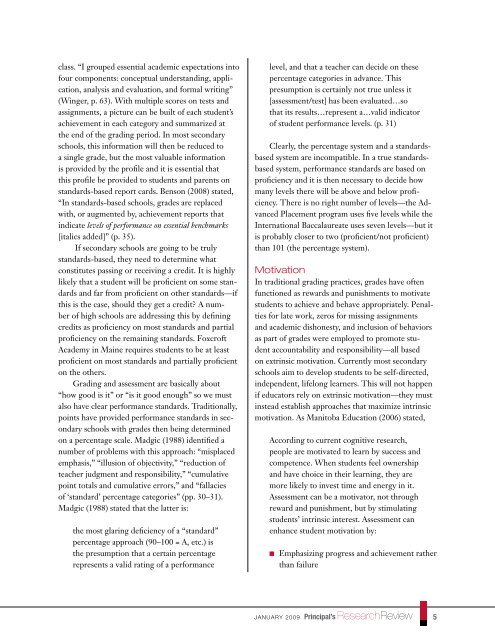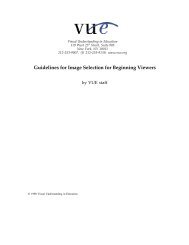Reforming Grading Practices in Secondary Schools - eStaffRoom
Reforming Grading Practices in Secondary Schools - eStaffRoom
Reforming Grading Practices in Secondary Schools - eStaffRoom
You also want an ePaper? Increase the reach of your titles
YUMPU automatically turns print PDFs into web optimized ePapers that Google loves.
class. “I grouped essential academic expectations <strong>in</strong>to<br />
four components: conceptual understand<strong>in</strong>g, application,<br />
analysis and evaluation, and formal writ<strong>in</strong>g”<br />
(W<strong>in</strong>ger, p. 63). With multiple scores on tests and<br />
assignments, a picture can be built of each student’s<br />
achievement <strong>in</strong> each category and summarized at<br />
the end of the grad<strong>in</strong>g period. In most secondary<br />
schools, this <strong>in</strong>formation will then be reduced to<br />
a s<strong>in</strong>gle grade, but the most valuable <strong>in</strong>formation<br />
is provided by the profile and it is essential that<br />
this profile be provided to students and parents on<br />
standards-based report cards. Benson (2008) stated,<br />
“In standards-based schools, grades are replaced<br />
with, or augmented by, achievement reports that<br />
<strong>in</strong>dicate levels of performance on essential benchmarks<br />
[italics added]” (p. 35).<br />
If secondary schools are go<strong>in</strong>g to be truly<br />
standards-based, they need to determ<strong>in</strong>e what<br />
constitutes pass<strong>in</strong>g or receiv<strong>in</strong>g a credit. It is highly<br />
likely that a student will be proficient on some standards<br />
and far from proficient on other standards—if<br />
this is the case, should they get a credit? A number<br />
of high schools are address<strong>in</strong>g this by def<strong>in</strong><strong>in</strong>g<br />
credits as proficiency on most standards and partial<br />
proficiency on the rema<strong>in</strong><strong>in</strong>g standards. Foxcroft<br />
Academy <strong>in</strong> Ma<strong>in</strong>e requires students to be at least<br />
proficient on most standards and partially proficient<br />
on the others.<br />
<strong>Grad<strong>in</strong>g</strong> and assessment are basically about<br />
“how good is it” or “is it good enough” so we must<br />
also have clear performance standards. Traditionally,<br />
po<strong>in</strong>ts have provided performance standards <strong>in</strong> secondary<br />
schools with grades then be<strong>in</strong>g determ<strong>in</strong>ed<br />
on a percentage scale. Madgic (1988) identified a<br />
number of problems with this approach: “misplaced<br />
emphasis,” “illusion of objectivity,” “reduction of<br />
teacher judgment and responsibility,” “cumulative<br />
po<strong>in</strong>t totals and cumulative errors,” and “fallacies<br />
of ‘standard’ percentage categories” (pp. 30–31).<br />
Madgic (1988) stated that the latter is:<br />
the most glar<strong>in</strong>g deficiency of a “standard”<br />
percentage approach (90–100 = A, etc.) is<br />
the presumption that a certa<strong>in</strong> percentage<br />
represents a valid rat<strong>in</strong>g of a performance<br />
level, and that a teacher can decide on these<br />
percentage categories <strong>in</strong> advance. This<br />
presumption is certa<strong>in</strong>ly not true unless it<br />
[assessment/test] has been evaluated…so<br />
that its results…represent a…valid <strong>in</strong>dicator<br />
of student performance levels. (p. 31)<br />
Clearly, the percentage system and a standardsbased<br />
system are <strong>in</strong>compatible. In a true standardsbased<br />
system, performance standards are based on<br />
proficiency and it is then necessary to decide how<br />
many levels there will be above and below proficiency.<br />
There is no right number of levels—the Advanced<br />
Placement program uses five levels while the<br />
International Baccalaureate uses seven levels—but it<br />
is probably closer to two (proficient/not proficient)<br />
than 101 (the percentage system).<br />
Motivation<br />
In traditional grad<strong>in</strong>g practices, grades have often<br />
functioned as rewards and punishments to motivate<br />
students to achieve and behave appropriately. Penalties<br />
for late work, zeros for miss<strong>in</strong>g assignments<br />
and academic dishonesty, and <strong>in</strong>clusion of behaviors<br />
as part of grades were employed to promote student<br />
accountability and responsibility—all based<br />
on extr<strong>in</strong>sic motivation. Currently most secondary<br />
schools aim to develop students to be self-directed,<br />
<strong>in</strong>dependent, lifelong learners. This will not happen<br />
if educators rely on extr<strong>in</strong>sic motivation—they must<br />
<strong>in</strong>stead establish approaches that maximize <strong>in</strong>tr<strong>in</strong>sic<br />
motivation. As Manitoba Education (2006) stated,<br />
Accord<strong>in</strong>g to current cognitive research,<br />
people are motivated to learn by success and<br />
competence. When students feel ownership<br />
and have choice <strong>in</strong> their learn<strong>in</strong>g, they are<br />
more likely to <strong>in</strong>vest time and energy <strong>in</strong> it.<br />
Assessment can be a motivator, not through<br />
reward and punishment, but by stimulat<strong>in</strong>g<br />
students’ <strong>in</strong>tr<strong>in</strong>sic <strong>in</strong>terest. Assessment can<br />
enhance student motivation by:<br />
n Emphasiz<strong>in</strong>g progress and achievement rather<br />
than failure<br />
january 2009 Pr<strong>in</strong>cipal’s ResearchReview 5






